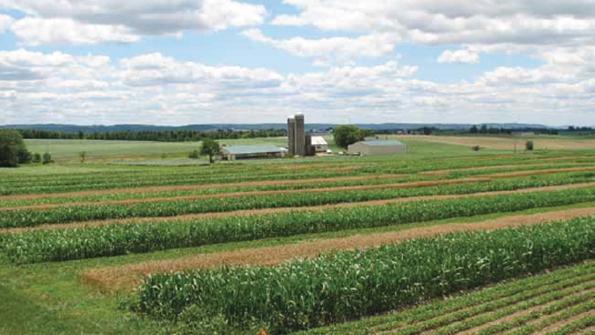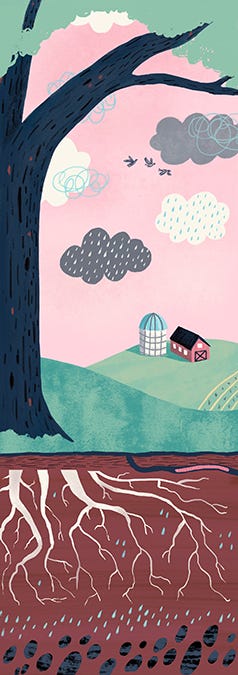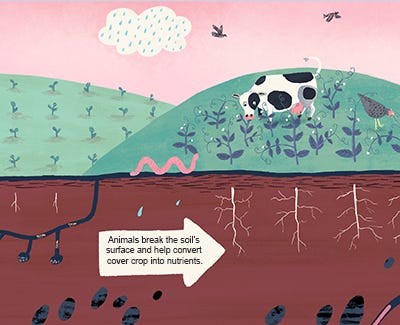Deteriorating soil causes problems with our food supply and, surprisingly, leads to more carbon in the atmosphere. See what farmers and nonprofit organizations are doing to improve our farmland and our environment.

It’s barely May, but Aspen Moon Farm is bustling with fall harvest-like activity. The inclusion of seedlings in its offerings makes today’s farmers market preparations hum. At least half a dozen helpers line the long dirt drive up to the house, where owner Jason Griffith breaks for a sandwich in his enclosed patio. At 45, Griffith has been farming this plot of land in Hygiene, Colorado, for just a few years—but long enough to expand to 10 acres and learn some critical lessons.
"When I first started farming I was gearing all of my production toward 'how many crops can I get out of this bed or that bed and how intensely can I plant?'" he says. That approach—despite organic and biodynamic cultivation—resulted in soil degradation, evidenced by diminished plant health and increased pests. Griffith reassessed his multiple annual harvests."We realized we were going to wear that field out quickly. It was interesting to see how fast it could happen." Wearing out the field is not unique—modern agriculture relies on synthetic chemicals for fertility, too often viewing soil simply as an inert growing medium. What’s unique about Griffith—as with other small-scale organic farmers dependent on nutrient- rich soil—is he chose to do something about it.
Doing something about it is indeed the recommendation of the United Nations Food and Agriculture Organization (FAO). Its 2015 report states that “33 percent of land is moderately to highly degraded.” In fact, the report reads, “the majority of the world’s soil resources are in only fair, poor or very poor condition.”
For Griffith, the solution unfolded by reframing the farming effort. "It’s really just about changing the focus from the crop to the soil and what does the soil need so we don’t have to add a ton of fertility every year." Reducing added fertilizers—natural or otherwise—meant giving scheduling priority to soil-building crops above revenue-producing ones. "Instead of setting up my schedule and saying, ‘I need to plant carrots, beets and all this stuff where I want, whenever I want,’" Griffith says, "I’m basically saying: ‘I need to have a cover crop in this field by this date.’” Then he determines what vegetables work in rotation. The result is a productive farm with a year-round focus on maintaining or improving soil fertility.
This emerging awareness often comes in three words: Soil is alive. And with that comes the breadth of reasons to take care of it. Hint: It’s not just about food.
The dirty truth
It would be difficult to find a more passionate soil advocate than Tom Newmark. The former CEO of New Chapter supplement company, Newmark is cofounder and board chair of The Carbon Underground and co-owner of Finca Luna Nueva lodge and biodynamic farm in Costa Rica.
By phone, Newmark launches into a landslide of daunting truths. “Because of the worldwide destruction of between 50 and 70 percent of the fertile soil in which we grow our food … ” he says, also citing the FAO, “we have only 60 harvests [years] left before the world loses its ability to produce any food.”
Beyond dwindling food production, Newmark lists impending dangers, such as desertification—or drying up—of farm and range lands and a water cycle “so warped and distorted that much of the planet is whipsawed by either drought or flood.” If you’re concerned about the devastating weather extremes that have become far too common, he says, “You have to be concerned about soil.”
He explains how soil carbon correlates with soil organic matter: the rich, decomposing material and microbiology of the soil ecosystem. Acting as what he calls “the soil/water battery,” each percentage point of soil organic matter is able to hold between 20,000 and 70,000 gallons of water per acre. “When you don’t have the top soil, when you don’t have the organic matter in the soil, then the soil can’t store the rain, and plants can’t handle climate extremes because they don’t have water reserves in the soil,” Newmark says. The ripple effect of this includes local relative humidity, which distorts cloud formation and rain. “The destruction of the planet’s soil therefore has an immediate and direct effect on drought, crop failure and desertification.”
Possibly the biggest and most overlooked ecological service soil provides, however, is its role in climate change—via carbon sequestration. Global soils are, in fact, massive carbon storehouses—yes, that carbon: the temperature-raising, sea level-raising stuff of inconvenient headlines. The opportunity to lock this excess atmospheric carbon into the ground is at the root of a movement called regenerative agriculture. But with this comes awareness of the inverse impact: the vast release of carbon by agricultural means. “In fact,” Newmark says, “somewhere around 40 percent of the excess carbon dioxide in the atmosphere comes directly from the soil.” That’s astounding in a world where human solutions to human-caused climate change tend toward the cars we drive and the lights we turn off. Newmark’s 40 percent is difficult to substantiate.

A U.N. paper puts it closer to 30 percent. But, says Newmark, that doesn’t account for the soil organic matter oxidized due to tilling or nitrogen fertilization.
Regardless, in the broad view of climate change there’s a double win that comes from carbon-rich soil. In addition to slowing or even reversing atmospheric carbon, soils richer in carbon (read: sticky, quenched) are also more resilient to the impacts of climate change.
This is good news, and it sounds even better the astonishingly simple way Newmark puts it: The soil lost its carbon, it wants it back and it knows how to get it. “There’s actually technology that is time-tested, safe and available worldwide for free that will take all the carbon we have irresponsibly let loose in the environment and bring it back to earth. That technology is called photosynthesis.” There’s a third win, too: Getting that carbon into the soil is synonymous with the soil fertility Griffith is looking for.
“The bad news is, we’ve absolutely botched things up with agricultural malpractice in the last 50 years,” Newmark says. “The good news is we can put the carbon back in the soil, recreate fertility, recreate the soil/water battery, recreate food stability and reverse climate change by using agriculture that is in accordance with the laws of nature and not at war with the laws of nature.”
Fixing nitrogen
“The number-one thing we absolutely have to do is to stop using synthetic nitrogen fertilizer,” Newmark says. “It’s just that simple, and the research worldwide is clear: The use of synthetic nitrogen fertilizer corresponds with the destruction of soil organic matter and the release of CO2 into the atmosphere.”
We have long known the dangers of nitrogen fertilizer. Its rampant use has been linked to coastal dead zones, fish kills, groundwater pollution, air pollution and even “reduced crop, forest and grassland productivity,” according to the United Nations Environment Program (UNEP). What is newer to the dump on nitrogen is its direct correlation to carbon release and climate change. But, hold on: Nitrogen is a necessary plant nutrient, and the now 100-year-old ability to synthesize nitrogen from thin air is a key part of the agricultural “Green Revolution” that brought more food, more quickly, to more mouths in the mid-twentieth century. The need for nitrogen is what makes synthetic fertilizer so effective, and effectiveness is what makes its use so widespread.
What Newmark describes, though, is a distorted ecosystem, starting with an artificial growth factor—synthetic nitrogen—that stimulates a “rapid, wild cascade of growth of soil microbiome in an almost cancerous form.” Microbiological aliveness is a measure of soil health, but its unchecked growth creates an imbalance. It all comes
down to complex underground trade negotiations, Newmark explains. In order to uptake nitrogen naturally, plants undergo an elaborate exchange with soil bacteria. Although both carbon and nitrogen are amply available in the air, they are inaccessible depending on who’s asking for it. Plants can’t get at the nitrogen; bacteria can’t get the carbon. “But,” says Newmark, “the bacteria have the nitrogen and the plants have this carbohydrate [carbon in the form of plant sugars] so at the tip of the root of every plant there’s an exchange that can happen, where the plants can swap their carbon-rich sugars for the biologically available nitrogen that the bacteria have. Brilliant!” And natural.
Until the introduction of synthetic nitrogen fertilizer, that is. With it the plant has received biologically available nitrogen without having to put forth the effort of feeding the bacteria. A conditioned laziness ensues, closing a trade that includes not just nitrogen, but a host of micronutrients, too. “The whole underground economy shuts down,” says Newmark, “because we’ve been giving crack cocaine to the plants.”
What needs to happen, Newmark says unequivocally, is “all agricultural systems that rely on synthetic nitrogen fertilizers have to be abandoned, and they have to be abandoned quickly. We don’t have time to debate this issue.”
The second thing we have to do, Newmark says, is leave the carbon in the soil when it gets there. “If you have carbon that is in a relatively stable form in the soil, you have to leave it there, leave that structure undamaged.” But, he says, deep and repeated plowing, or tilling, breaks apart soil structure and releases CO2 back into the atmosphere. “We have to stop doing that,” says Newmark. “We have to stop ripping apart the thin layer of topsoil that covers much of our land surfaces on the planet.”

Easy does it
While Newmark’s recommendations are satisfyingly simple biologically, they are not easy to apply within the existing industrial agricultural system—especially without consensus. In fact, many believe abandoning synthetic nitrogen fertilizer is akin to ditching the internet or stepping away from the car. Rob Saik, founder and CEO of Agri-trend, whose mission is “to help farmers … produce a safe, reliable and profitable food supply in an environmentally sustainable manner,” specializes in soil chemistry, plant physiology and crop nutrition, seeing GMOs and agri-chemicals as critical tools. “I think there’s a lot that can be done to make better use of nitrogen fertilizers,” he says. “The goal is not to reduce them but to use them more efficiently.”
Jeff Pizzey is a fifth-generation farmer in western Manitoba, Canada, and one of Saik’s clients. Pizzey says it’s synthetic fertilizers that allow him to grow as effectively as he does—as effectively as the world needs its farmers to. “What part of the population are you going to decide is not going to eat?” Pizzey asks about discontinuing synthetic nitrogen fertilizer. “There is absolutely no way that our world could sustain itself without it.”
Further, Pizzey says he’s able to employ a no-till approach because of synthetics. “That’s the one thing organic farming has not moved on from. Tillage is the only tool they have in their toolbox to kill weeds.” Because of genetically modified crop strains and their accompanying herbicides Pizzey can run his farm with minimal tilling.
“We use a disk drill, which basically cuts and slides the soil in a small band about three-quarters of an inch wide, places the seed and covers it back up again.”
Even the Rodale Institute, a world leader in practical organic farming research, agrees that no-till, by “relying on herbicides for weed control … cannot be directly adopted for use in organic production systems.” Rodale is researching and teaching methods to make no-till and reduced-till organic farming possible.
Aspen Moon’s Griffith does what he can as an organic farmer. “There’s not a lot of vegetable farmers that are no-till per se. We all have to turn in that vegetable residue to be able to get ready for the next crop.” The chisel plow Griffith uses to aerate and break up the soil is indeed more disruptive than Pizzey’s disk drill, but less so than a rototiller. “We don’t use a rototiller because … it inverts the soil.” Different microbes live at different levels in the soil, he explains, “so when you invert that soil every time, you basically kill the life of the soil that now has to rebuild.”
As for yields, Rodale differs markedly from Pizzey. Its 30-year trial reveals organic yields equal to or greater than conventionally grown controls—especially in drought years when organic soils show greater resiliency. Even studies that report lower organic yields show more nutritional value per acre. Newmark leapfrogs the entire argument. “Tell me,” he says, “how will conventional farms produce food with no topsoil?”
Reversing the damage
Agriculture, by nature, captures nutrients from the farm and exports them to market. With nutrients constantly being removed from the ecosystem, farmers need to manage soil fertility. How they do so is a defining characteristic. “We’re not trying to buy fertility to create a product,” says Griffith. “We’re trying to create fertility within the farm.”
There are two keys to that for Aspen Moon Farm. The first is cover crops.
With cover crops, nutrients collected through photosynthesis are captured and kept within the farm system. A cocktail of cover crops stocks the soil with different nutrients—including nitrogen. “A good cover crop should be able to feed next year’s crop,” Griffith says.

Griffith’s second key to building fertility is the inclusion of animals—not as product but as part of the operation. The best rule, Griffith says, works from cover crop through cow (quite literally) to chicken on the way to planting. “So the cow eats all that cover, which goes through its stomach process, turning it into almost compost right into the field. Then the chickens come by afterward, eat the bugs, eat the weed seeds, scratch it all up, spread it and then we’re ready to go.”
Ruminating on climate change
Bringing animals into—or back into—the farm system is intriguing, but counterintuitive considering the well-documented negative impact the meat industry has on climate. Confined in large, dirt-floored feedlots, they poorly digest grain shipped from a thousand miles away and gas up the atmosphere with the resulting methane—a greenhouse gas 25 times more potent than CO2. Indeed, a Proceedings of the National Academy of Sciences report released in early 2016 states, “Transitioning toward more plant-based diets that are in line with standard dietary guidelines could reduce … [2050] food-related green-house gas emissions by 29–70 percent.”
But recent research suggests that large grazing ruminants—like cows—can be climate heroes as well. Leading the drive on this is the Savory Institute, a nonprofit organization promoting “holistic management” as a top effort to revitalize soil health and lock atmospheric carbon into the earth.
Holistic management is a carefully timed system of growth, rapid grazing and regrowth, says Savory’s Chris Kerston. Regrazing, too, but not too soon. Here’s why: As the grazed grasses start regrowing above ground, their roots retract, sloughing off dead root material—which is critical. “When that piece of root dies off down there … you actually just injected organic matter into the soil,” says Kerston. Essentially, the plant—through photosynthesis and root sloughing—is pumping solar energy into the soil. In this way, “you can build depth into the soil much deeper at a much faster rate.” After the grasses regrow, the pasture may look fully recovered, but more time is required to allow the roots to regrow. Only then is it time to graze again. “What ranchers often don’t realize,” Kerston warns, “is if you don’t wait long enough for the root to also regrow, then we have an unsustainable situation—we’re going into the negative in our bank account.” The soil is missing its carbon deposits, and the plant, with insufficient root regrowth and excessive withdrawals, is suffering. Eventually the grasses stop regrowing up top, too, taking the grass out of grassland. Hence, desertification.
“So what we want to have happen,” Kerston continues, “is we want our animals bunched and moving, but we want them to be gone long enough that the land fully recovers.” That nuance is the basis of holistic management, and it, says Kerston, “makes all the difference in the world. Quite literally.”
Bunched and moving is exactly what herds of large ruminants have been for millennia. The grazing was rapid, thorough and unselective because the animals were bunched and competing for limited grasses. They were bunched—and moving—because of the omnipresence of stealthy predators. “So in our sedentary ranching systems, when we started putting up barbed wire fences it was one of the worst things to happen to agriculture,” says Kerston.
Fortunately, bunched and moving can coexist with property lines, and this is where Savory’s holistic management comes into play: teaching ranchers how to choreograph the moves (and bunches) in a way that mimics the natural world, and teaching farmers how to create a beneficial mixture of flora and fauna working together, says Kerston. “If we put animals back on the land that is growing corn to feed animals thousands of miles away, that whole broken cycle stops.” Instead of eating bought feed, “the animals can eat crop residues, they can fertilize soils, they can actually break up the soil surface getting it ready for planting.”

Texas A&M’s Richard Teague, PhD, is among those to document the benefits of this specialized rotational grazing. Teague performed a large-scale multiyear study of regenerative agricultural practices. His study compared similar plots of land and employed different grazing methods on each, tracking the vegetation on lands with no grazing, continuous grazing (studying both light and heavy continuous grazing separately) and rotational grazing, “using light to moderate defoliation … followed by adequate recovery before regrazing.” Rotational or “multipaddock” grazing, he concludes, “had superior vegetation composition, higher soil carbon, and higher water- and nutrient- holding capacities.”
Returning key biological processes to their natural state seems to be at the core of transferring excess carbon from the atmosphere—where it’s a liability—to the soil, where it’s of vast benefit. That’s good news because it means soil loss and climate change have a common solution, and all we have to do to harness it is step aside. “We have 470 million years of experience of the ecosystem producing food: converting solar energy into calories available for biology to consume,” says Newmark.
When asked how quickly damaged lands begin to heal, Newmark’s response is short and cheerful. “It’s instantaneous!” It takes longer, he admits, to completely reverse the damage, but the healing starts on day one. Citing Teague’s research, he speaks of rivers that had disappeared or become seasonal during the downward spiral of desertification. In Teague’s study, he says, “those ephemeral streams became permanent streams. And this was in just 10 years!”
“I wake up hopeful every morning,” Newmark says, “because the solution is literally right beneath our feet.”
This article was originally printed in Delicious Living magazine, a sister publication of newhope.com.
About the Author(s)
You May Also Like




